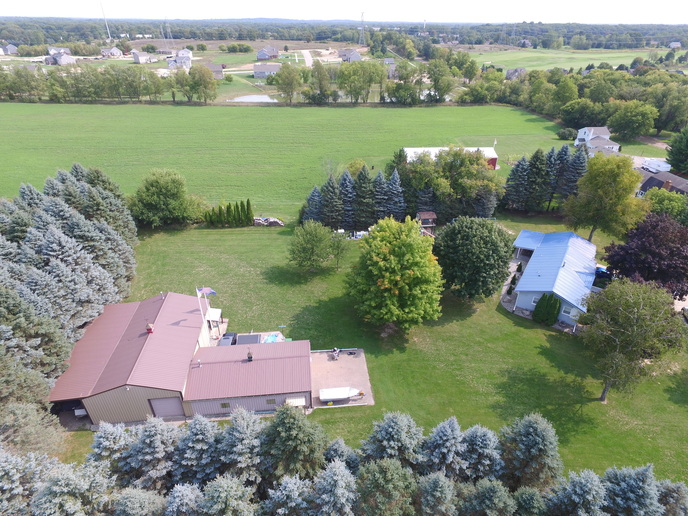I have a 6 year old 45' by 88' pole barn with 17' at the eve. No over hangs on the roof except for a couple inches of tin. Doors on both ends. I would like to continue the 4/12 roof slope. Contractor I have been talking with says he likes to use half trusses. Just cuts two holes in existing tin and upper and lower cords go through and are anchored to the pole. The problem is I do not have the head room I would like with the half truss since it has a lower cord. I think he said it would be around 10 feet and I have a couple specific things I would like to store in there that require more like 11' or so - one thing being a camper. I guess I could use 2 by 12's or glued up manufactured lumber. On an 8 foot rafter spacing what size does it take to go out 12 or 16 feet? Probably 12' out would be a waste of time and probably should figure 16 feet outward. Thanks.
You are using an out of date browser. It may not display this or other websites correctly.
You should upgrade or use an alternative browser.
You should upgrade or use an alternative browser.
- Thread starter andy r
- Start date
Janicholson
Well-known Member
8 foot rafter spacing would require serious support between them to handle the roof tin and snow loads! The building codes where you live will drive the needed load requirements. A ledger of doubled 2X12 bolted to the poles with shims to hold it away from crushing the existing tin could hold trusses at 2 foot on center, using metal hangers on the chord and rafter. Trusses can be made with raised chords to create your clearance. Jim
Northvale PA
Member
You can look up a lumber chart on the web and get the allowable spans for your snow load area. Try https://www.weyerhaeuser.com/woodproducts/document-library/document_library_detail/lb-4026/#download
One thing to determine is your dead load and snow load and what grade of lumber you want to pay for. It appears you can easily use straight rafters.
One thing to determine is your dead load and snow load and what grade of lumber you want to pay for. It appears you can easily use straight rafters.
Northvale PA
Member
Link didnt work. Look up Weyerhaeuser framing lumber charts.
mtf
Member
- Location
- Bottom of the Bluegrass State
Snow load where you are is critical!
Here at the bottom of KY, I have done that very thing. Bolting 2 x 12 ledger to posts and use joist hangers and 2 x 10 rafters 24 o.c. Of course 2 x 4 purlins every 2 foot, layed on the flats.
Here at the bottom of KY, I have done that very thing. Bolting 2 x 12 ledger to posts and use joist hangers and 2 x 10 rafters 24 o.c. Of course 2 x 4 purlins every 2 foot, layed on the flats.
Steve@Advance
Well-known Member
Are you planning on using the contractor, or just asking for his advice?
If hiring him, bring him back and explain why you want to make changes. He should accommodate you!
If hiring him, bring him back and explain why you want to make changes. He should accommodate you!
DoubleO7
Well-known Member
- Location
- Crystal River, FL
Maybe consider red metal for structure?
Geo-TH,In
Well-known Member
If you had to get a permit to build the pole barn, like I had to, you better ask your county building inspector.
Getting a permit also gives the county assessor a record of your property to tax.
Failing to get a permit is a stiff fine plus you still have to pay for the permit after the fact.
Getting a permit also gives the county assessor a record of your property to tax.
Failing to get a permit is a stiff fine plus you still have to pay for the permit after the fact.
caterpillar guy
Well-known Member
If you can set some more poles or put in a 2x12 for a plate on the inside of the existing poles. You could depending on snow load put 2x6 or 8 planks on for rafters at 3 foot spacing setting the lower end on another pair of 2x12's for a plate this would eliminate the nonsense of hangers and with a stub fastened in between the plates and rafter fastened to that will not be a wind issue. We have 3 pole barns built like this and all over 30 years or more old and a lean to that is over 30 years old all still standing with no issues. though we did use rough sawed lumber from the woods so it ia all built from Elm Oak both red and white as well as Ash. No permits nor inspections needed back then. I guess the fact that in MI and they are still standing says it all. No the poles are not cemented in nor a block under them just set in the ground with no settling. Clay dirt. For the lower end you could even use poles for the rafter to set on though over kill and cost for 3 foot rafter spacing. 2 2x12's on each side of the pole will hold it and bolt them after getting building up will work fine. We use 1 5/8 bolt through the pole and plates with a scab plank on the inside and a steel plate on the outside. This will allow room for a door track if wanted and the scab plank on the inside is bolted lapping about 3 feet on each end. Dad didn't trust just the pole barn nails with the brittleness of them to hold it. All the sheds have the bolted method on them. We used 20 foot 2x6's for the leanto so probably about 16-17 foot of usable width to it. I would put tape on the lap joints of the sheets if using steel to seal from water running over the laps as it gets down closer to the bottom end with snow and slush on it.
Geo-TH,In
Well-known Member
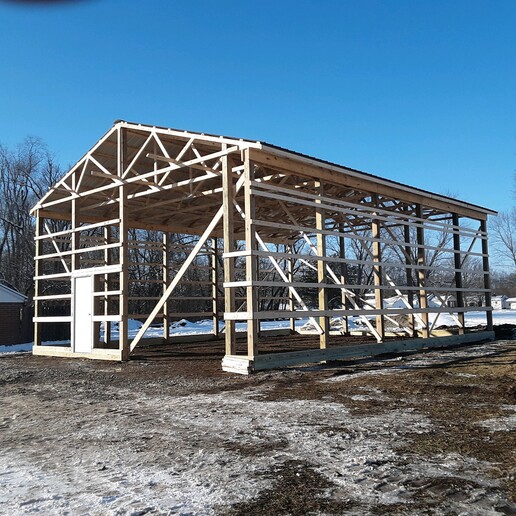
My trusses are resting on two 2x12.
My trusses are on 4 ft centers.
Why not have 1/2 trusses made at Menards truss factory in Terre Haute. Connect the 1/2 trusses to the existing trusses?
Then attach another 2x12 for the bottom half the the half truss to connect to.
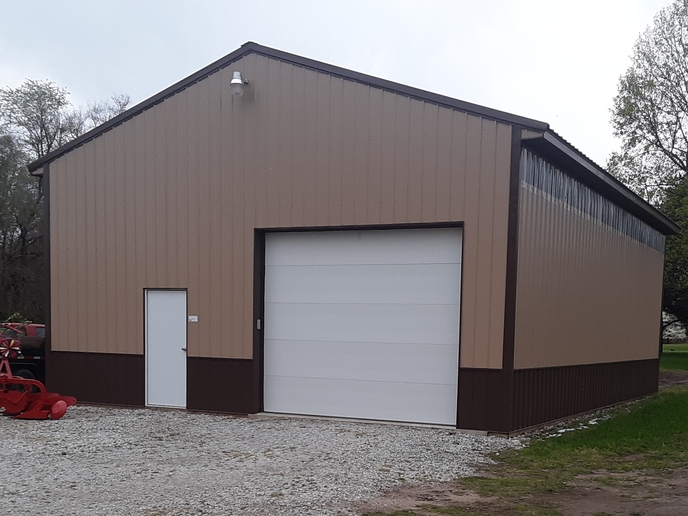
I insist on 1 ft vented eves. No green stuff growing on the walls. No condensation on the inside of the roof either.
No, heat and no insulation.
BarnyardEngineering
Well-known Member
- Location
- Rochester, NY
The rafters don't need to be on 8' centers.
Secure a ledger board to the posts, such as a 2x12 or engineered lumber, and then hang the rafters off the ledger board using joist hangers. You can go 16" or 24" on center and use 2x6's or 2x8's, which will gain you even more height.
Secure a ledger board to the posts, such as a 2x12 or engineered lumber, and then hang the rafters off the ledger board using joist hangers. You can go 16" or 24" on center and use 2x6's or 2x8's, which will gain you even more height.
Steve in VA
Well-known Member
- Location
- Natural Bridge Virginia
Ok, now this may be of no value since I haven't seen your place. That said, is it possible to cut the ground down? As I read your situation you're only looking for 1 ft so maybe lower the grade on that side. Kinda a don't raise the bridge; lower the river.
You need 4 feet of rise for every 12 feet of run. You could add a 12' lean to with the roof at 13' on the outside edge. If you dropped it 5' you could have a 15' wide (excluding post) lean to with roof at 12' high on the outside edge. With that you need 15'9 rafters - get 16' rafters and trim the edges vertical with the ground and then buy 16' sheets of tin and you'll have a couple inches of overhang. Use hangers and attach to the existing ledger board. I would use 2X6 on 24 centers. Just make sure your ledger board is firmly attached to the post - I found mine were only nailed (!) with 5 nails. I drilled a hole and using a 3/8 carriage bolt I bolted them to the post in addition to the nails and single 6 lag screw. You can run the screws through the existing tin for the hangers. I have added a lean to both sides of my 40X30 shed - effectively making it a 40X60 shed. I screwed everything together and used 6X6 posts. Nothing has ever moved and its solid. I used 2X4 nailers and put them on 24 centers also. Everything wood was screwed together using 3 screws and the sheet metal was screwed on using 1 3/4 screws in the flats.
I am assuming you have top ledger board like Geo-TH,In has in his picture. On my shed the top ledger board was a 2X10 running around the outside of the shed with second on the inside. I also doubled up the ledger board with a 2X8 on both the inside and outside of the posts on the lean to.
Blackhole49
Well-known Member
- Location
- White Lake MI
Something to consider. I will preface this with I'm not and engineer and didn't consult with one. I added this 13' x 48' lean to to my 12' high barn in 2006. I tied into the top of my 2' on center trusses and flattened the pitch because I wanted 13' clearance under it. I live in SE MI and have 3 such lean to's on my property and snow load has never been an issue. The one on my house was under designed (2x4 rafters) and built in 1985 as temporary storage for my boat and tractor until I could afford a barn. Temporary seems to have turned into permanent. I will admit, once I decided the one on the house was never coming down, I doubled up the 2x4s.
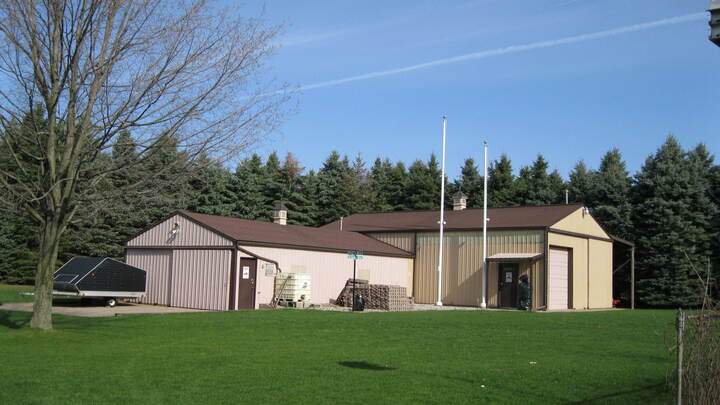
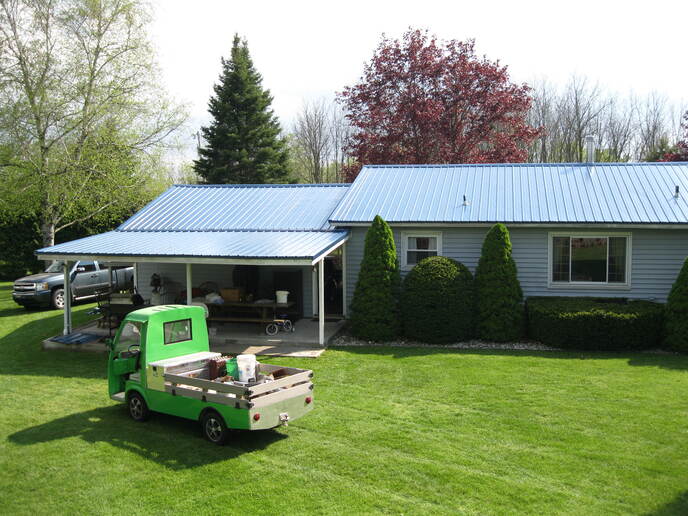


Blackhole49
Well-known Member
- Location
- White Lake MI
Russ from MN
Well-known Member
- Location
- Bemidji MN
I would not change the pitch, it creates a pocket for snow to accumulate. I would extend the existing rafters with 2x12's bolted together, as many as you need per a structural engineers advice. Many contractors like pre-built trusses because it takes the liability off of them. I found a real carpenter when we remodeled out house roof, and he and I decided together what to do, and it worked very well!
Similar threads
- Replies
- 17
- Views
- 4K
- Replies
- 15
- Views
- 671
We sell tractor parts! We have the parts you need to repair your tractor - the right parts. Our low prices and years of research make us your best choice when you need parts. Shop Online Today.
Copyright © 1997-2024 Yesterday's Tractor Co.
All Rights Reserved. Reproduction of any part of this website, including design and content, without written permission is strictly prohibited. Trade Marks and Trade Names contained and used in this Website are those of others, and are used in this Website in a descriptive sense to refer to the products of others. Use of this Web site constitutes acceptance of our User Agreement and Privacy Policy TRADEMARK DISCLAIMER: Tradenames and Trademarks referred to within Yesterday's Tractor Co. products and within the Yesterday's Tractor Co. websites are the property of their respective trademark holders. None of these trademark holders are affiliated with Yesterday's Tractor Co., our products, or our website nor are we sponsored by them. John Deere and its logos are the registered trademarks of the John Deere Corporation. Agco, Agco Allis, White, Massey Ferguson and their logos are the registered trademarks of AGCO Corporation. Case, Case-IH, Farmall, International Harvester, New Holland and their logos are registered trademarks of CNH Global N.V.
Yesterday's Tractors - Antique Tractor Headquarters
Website Accessibility Policy


